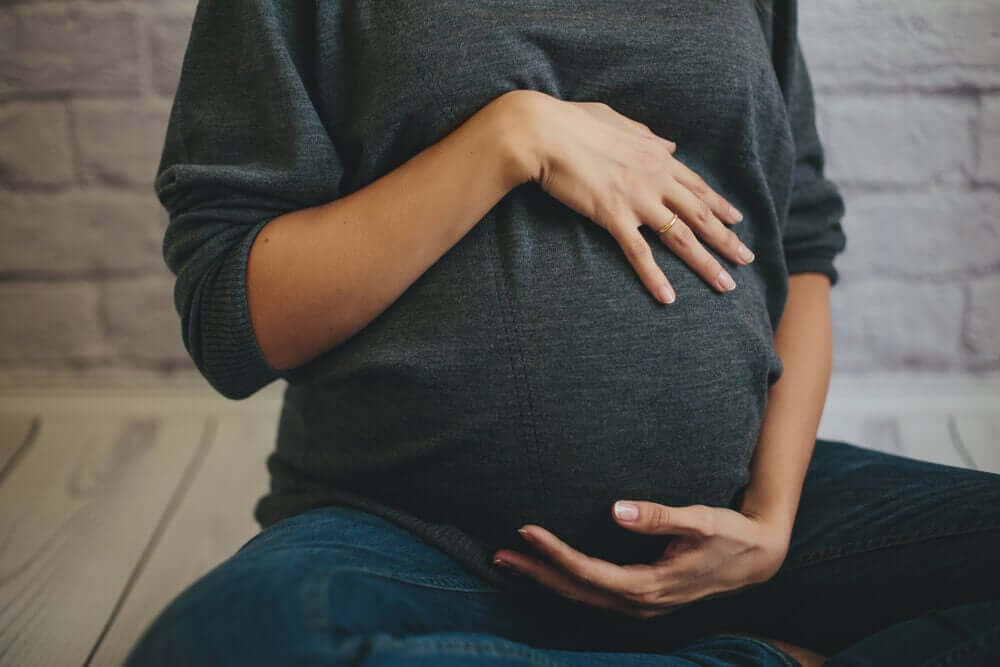Polytrauma and Pregnancy in Women


Written and verified by the nurse Miriam Barriga Sánchez
The link between polytrauma and pregnancy is becoming more common because women tend to keep working until the end of pregnancy. In addition, it also has to do with spending more time in the car.
The combination of these factors has led to an increase in obstetric trauma, and is influencing the health of both mothers and babies.
Pregnant women have different physical and physiological characteristics than non-pregnant women. Therefore, it’s important to know how to treat polytrauma and pregnancy in the best possible way.
Polytrauma and pregnancy
Trauma has become the main cause of non-obstetric death during pregnancy. Within the mother-fetus binomial, they can suffer injuries from the trauma itself and from pregnancy.
The anatomical and physiological changes that happen to women during pregnancy are able to change your body’s response to the same trauma. Therefore, these factors will influence the effects of polytrauma in pregnancy:
- How far along the pregnancy is
- Type and severity of the trauma
- Changes in the fetus or placenta
In fact, it’s important to take care of the mother first. Then, later on, when the mother is stabilized, she can take care of the baby better.

Cardiovascular system
Due to the changes that happen during pregnancy, pregnant women have more blood. Therefore, it’s important to control any internal bleeding that could happen from the trauma.
This increase in blood volume means that the mother takes longer to go into shock. The baby would lose oxygen a lot earlier. That’s why, although blood loss doesn’t seem to affect the mother, you need to treat it quickly.
Perineal organs
It’s also important to look for possible injuries in the vagina, perineum and rectum after the trauma. These could mean that there are problems with the obstetric-gynecological area.
Cardiopulmonary resuscitation (CPR)
For CPR in pregnant women, there is controversy about when to do a C-section if CPR doesn’t work. Some say to do it after a set time of CPR, some say to do it all at the same time.
To make a decision, you need to take other factors into account. For example, if the fetus is older than 24 weeks, maternal status, etc.
Penetrating injuries
When the fetus grows in the uterus, it causes organs to move. Therefore, it increases the risk of damage to the uterus, and decreases damage to other organs.
The uterine muscle, amniotic fluid and fetus make it possible to absorb a lot of energy from the penetrating object. That way, it minimizes damage to other organs.
Polytrauma and pregnancy: specific injuries for pregnant women
There are certain injuries that only appear in cases of polytrauma and pregnancy.
Uterine trauma
A blow to the uterus can cause the uterine muscle to rupture. This is called myometrium. In addition, the rest of its layers will be bad, both for the mother and baby.
Uterine rupture can be complete or incomplete, and usually has these signs and symptoms:
- Baby’s heart rate decreases
- Abdominal pain
- Less or no contractions (if present before)
- Maternal tachycardia or low blood pressure from blood loss
- Vaginal bleeding
- Hematuria (blood in urine)
- Ascent of the fetus if the fetus is expelled to the abdominal cavity
Treatment in the case of uterine rupture focuses on stabilizing the mother and anesthesia. In addition, they may need surgery (laparotomy) to remove the fetus.

Uterine contractions
Uterine contractions can happen before going into labor. This can happen after trauma, in stressful situations, if you’re dehydrated, etc. It’s the most common obstetric problem from trauma.
Depending on the situation of the mother and baby, there are different approaches. Every situation is different. For example, it depends on whether the amniotic sac is complete or not, what week of pregnancy they’re at, fetal and maternal status, and more:
- Maternal and fetal monitoring
- Administration of tocolytic medication to stop contractions
- Let the delivery go on
- Expected attitude
Placental detachment
Because of polytrauma and pregnancy, it could also cause placental detachment. This is partial or total detachment of the placenta before the baby is born after 20 weeks.
This situation is an emergency, since the placenta is the organ that gives food and oxygen to the baby. If he’s completely detached, he’ll stop getting blood.
Some of the signs and symptoms that may appear are:
- Fetal hypoxia
- Visible or vaginal internal bleeding
- Abdominal pain
- Blood clots form throughout the body
- Shock and other complications
Treating this situation focuses on making sure the mother is stable. Also, it focuses on delivering the baby, either vaginally or from a C-section.
Fetal-maternal hemorrhage
Passing fetal blood to the mother is more common in women who have suffered trauma. Some of the consequences of this are:
- Rh sensitization in mothers with Rh- and baby with Rh+
- Arrhythmias
- Anemia
- Fetal death due to excess blood loss
To avoid Rh sensitization, all women with Rh- will receive Rh immunoglobulin. In addition, doctors will look at the mother and baby to decide what to do next.
Premature rupture of membranes
This is where the amniotic sac spontaneously ruptures before labor. Specialists will take the following things into consideration to decide what to do:
- Weeks of gestation and fetal maturity
- Amount of amniotic fluid lost
- Risk of infection
- Characteristics of amniotic fluid

Polytrauma and pregnancy: fetal injuries
In the trauma that occurs during pregnancy, fetal health is also at stake. One of the problems that the fetus could have, in addition to what we mentioned, is the risk of fetal distress.
The consequences of trauma on the fetus are also due to changes in the baby’s oxygen levels. Doctors diagnose fetal distress through monitoring, and the signs are:
- Changes in the baby’s heart rate
- Fetal decelerations after uterine contractions
Final thoughts on polytrauma and pregnancy
Every situation is different, so doctors will assess every case individually. In addition, depending on the state of the baby, they might have to take other measures.
The link between polytrauma and pregnancy is becoming more common because women tend to keep working until the end of pregnancy. In addition, it also has to do with spending more time in the car.
The combination of these factors has led to an increase in obstetric trauma, and is influencing the health of both mothers and babies.
Pregnant women have different physical and physiological characteristics than non-pregnant women. Therefore, it’s important to know how to treat polytrauma and pregnancy in the best possible way.
Polytrauma and pregnancy
Trauma has become the main cause of non-obstetric death during pregnancy. Within the mother-fetus binomial, they can suffer injuries from the trauma itself and from pregnancy.
The anatomical and physiological changes that happen to women during pregnancy are able to change your body’s response to the same trauma. Therefore, these factors will influence the effects of polytrauma in pregnancy:
- How far along the pregnancy is
- Type and severity of the trauma
- Changes in the fetus or placenta
In fact, it’s important to take care of the mother first. Then, later on, when the mother is stabilized, she can take care of the baby better.

Cardiovascular system
Due to the changes that happen during pregnancy, pregnant women have more blood. Therefore, it’s important to control any internal bleeding that could happen from the trauma.
This increase in blood volume means that the mother takes longer to go into shock. The baby would lose oxygen a lot earlier. That’s why, although blood loss doesn’t seem to affect the mother, you need to treat it quickly.
Perineal organs
It’s also important to look for possible injuries in the vagina, perineum and rectum after the trauma. These could mean that there are problems with the obstetric-gynecological area.
Cardiopulmonary resuscitation (CPR)
For CPR in pregnant women, there is controversy about when to do a C-section if CPR doesn’t work. Some say to do it after a set time of CPR, some say to do it all at the same time.
To make a decision, you need to take other factors into account. For example, if the fetus is older than 24 weeks, maternal status, etc.
Penetrating injuries
When the fetus grows in the uterus, it causes organs to move. Therefore, it increases the risk of damage to the uterus, and decreases damage to other organs.
The uterine muscle, amniotic fluid and fetus make it possible to absorb a lot of energy from the penetrating object. That way, it minimizes damage to other organs.
Polytrauma and pregnancy: specific injuries for pregnant women
There are certain injuries that only appear in cases of polytrauma and pregnancy.
Uterine trauma
A blow to the uterus can cause the uterine muscle to rupture. This is called myometrium. In addition, the rest of its layers will be bad, both for the mother and baby.
Uterine rupture can be complete or incomplete, and usually has these signs and symptoms:
- Baby’s heart rate decreases
- Abdominal pain
- Less or no contractions (if present before)
- Maternal tachycardia or low blood pressure from blood loss
- Vaginal bleeding
- Hematuria (blood in urine)
- Ascent of the fetus if the fetus is expelled to the abdominal cavity
Treatment in the case of uterine rupture focuses on stabilizing the mother and anesthesia. In addition, they may need surgery (laparotomy) to remove the fetus.

Uterine contractions
Uterine contractions can happen before going into labor. This can happen after trauma, in stressful situations, if you’re dehydrated, etc. It’s the most common obstetric problem from trauma.
Depending on the situation of the mother and baby, there are different approaches. Every situation is different. For example, it depends on whether the amniotic sac is complete or not, what week of pregnancy they’re at, fetal and maternal status, and more:
- Maternal and fetal monitoring
- Administration of tocolytic medication to stop contractions
- Let the delivery go on
- Expected attitude
Placental detachment
Because of polytrauma and pregnancy, it could also cause placental detachment. This is partial or total detachment of the placenta before the baby is born after 20 weeks.
This situation is an emergency, since the placenta is the organ that gives food and oxygen to the baby. If he’s completely detached, he’ll stop getting blood.
Some of the signs and symptoms that may appear are:
- Fetal hypoxia
- Visible or vaginal internal bleeding
- Abdominal pain
- Blood clots form throughout the body
- Shock and other complications
Treating this situation focuses on making sure the mother is stable. Also, it focuses on delivering the baby, either vaginally or from a C-section.
Fetal-maternal hemorrhage
Passing fetal blood to the mother is more common in women who have suffered trauma. Some of the consequences of this are:
- Rh sensitization in mothers with Rh- and baby with Rh+
- Arrhythmias
- Anemia
- Fetal death due to excess blood loss
To avoid Rh sensitization, all women with Rh- will receive Rh immunoglobulin. In addition, doctors will look at the mother and baby to decide what to do next.
Premature rupture of membranes
This is where the amniotic sac spontaneously ruptures before labor. Specialists will take the following things into consideration to decide what to do:
- Weeks of gestation and fetal maturity
- Amount of amniotic fluid lost
- Risk of infection
- Characteristics of amniotic fluid

Polytrauma and pregnancy: fetal injuries
In the trauma that occurs during pregnancy, fetal health is also at stake. One of the problems that the fetus could have, in addition to what we mentioned, is the risk of fetal distress.
The consequences of trauma on the fetus are also due to changes in the baby’s oxygen levels. Doctors diagnose fetal distress through monitoring, and the signs are:
- Changes in the baby’s heart rate
- Fetal decelerations after uterine contractions
Final thoughts on polytrauma and pregnancy
Every situation is different, so doctors will assess every case individually. In addition, depending on the state of the baby, they might have to take other measures.
All cited sources were thoroughly reviewed by our team to ensure their quality, reliability, currency, and validity. The bibliography of this article was considered reliable and of academic or scientific accuracy.
- Domínguez Picón F.M. Traumatismo en el embarazo. (2000). En: Rodríguez Rodríguez J.C. El traumatizado en urgencias: protocolos. 2ª edición. Madrid: Díaz de Santos; 2000. p. 157-168.
- Mejías Paneque C., Duarte González L., García González S. (2012). Consideraciones generales en la atención de urgencia a la paciente obstétrica politraumatizada. Enferm. glob. 11( 25 ): 464-469. Disponible en: http://scielo.isciii.es/scielo.php?script=sci_arttext&pid=S1695-61412012000100026&lng=es. http://dx.doi.org/10.4321/S1695-61412012000100026.
- Serra Serra V., Perales Marín A., Remohí Giménez J., Morillas Ariño C., Pellicer Martínez A. (2017). Urgencias en obstetricia. 1ª edición. Madrid: Editorial Médica Panamericana.
This text is provided for informational purposes only and does not replace consultation with a professional. If in doubt, consult your specialist.








